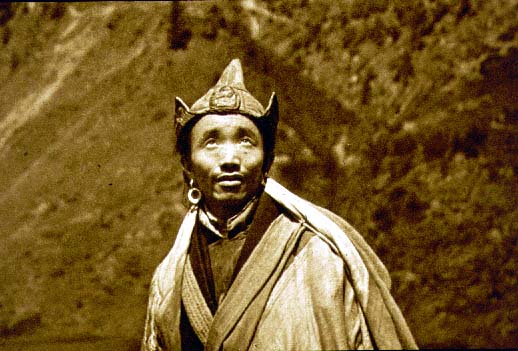
Gö-kar chang-lo Naljorpa from Kham
Wearing the ‘ri-chö’ – the mountain retreat hat
This unknown naljorpa (rNal ’byor pa – yogi) is wearing the ri-chö zha (ri chos zhwa) – a simple form of the Dorje Zahorma hat (za hor rGyal pa gTsug lag ’dzin gyi thob zhva) of the Nyingma Tradition. The ri-chö zha has flaps which pull down over the ears for warmth in cold weather. This naljorpa wears the red, white, and blue striped shawl of the gö-kar chang-lo’i dé (gos dKar lCang lo’i sDe) and the conch spiral earrings of the yogic tradition. In the Aro gTér tradition in the West the ri-chö zha is worn primarily by the newly ordained naljorpas (rNal ’byor pa) and naljormas (rNal ’byor ma).
The naljorpa in the photograph is wearing a ngak kyi zen (sNgags kyi gZan) the red and white yogic shawl with thin blue stripes. This shawl has a wealth of symbolism – but in the case of the naljorpas the red white and blue of the shawl represent the rTsa rLung system and the solar, lunar, and central channels respectively. The naljorpa wears the gomthag (sGom thag – meditation strap from Dzogchen long-dé) and the collared waistcoat (tö-thung phu’mèd – sTod thung phu ’med) which are typical of the naljorpa / naljorma tradition.
Ngak’chang Rinpoche comments:
According to the Sangwa Nyingpo (gSang ba sNying po) there were two distinct streams of the gö-kar chang-lo’i dé during the first spread of the teachings in Tibet – the ngakpas and ngakmas and the naljorpas and the naljormas. During the persecution of the gö-kar chang-lo’i dé in the Second spread these distinct lines of ordination merged and the distinctions become lost. Jomo Chhi’mèd Pema, who was a great scholar both of Sanskrit and the history of the Mahasiddhas, passed on her knowledge to her adoptive daughter Jomo Pema ’ö-Zér, who in turn passed it to Aro Lingma. This is the reason why Aro Lingma encouraged the re-instigation of the two lineages of ordination through Akyong Düd’dül Dorje and Gomchenma Künzang Rang-rig. Akyong Düd’dül Dorje held the ngakpa / ngakma line and Gomchenma Künzang Rang-rig held the naljorpa / naljorma line. The ngakpa / ngakma ordination line was based in the Mahayoga, and the naljorpa / naljorma ordination line was based in Anuyoga – but both lines also practised Dzogchen. There was no Dzogchen ordination since Dzogchen is a non-symbolic, non-ritual vehicle.
